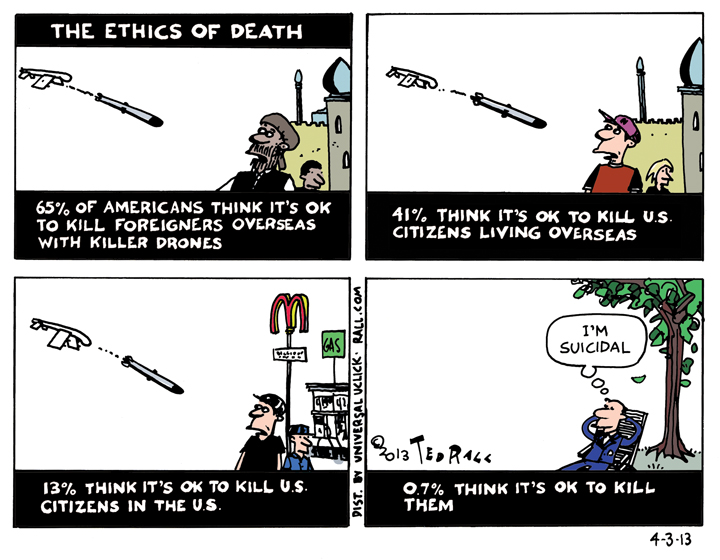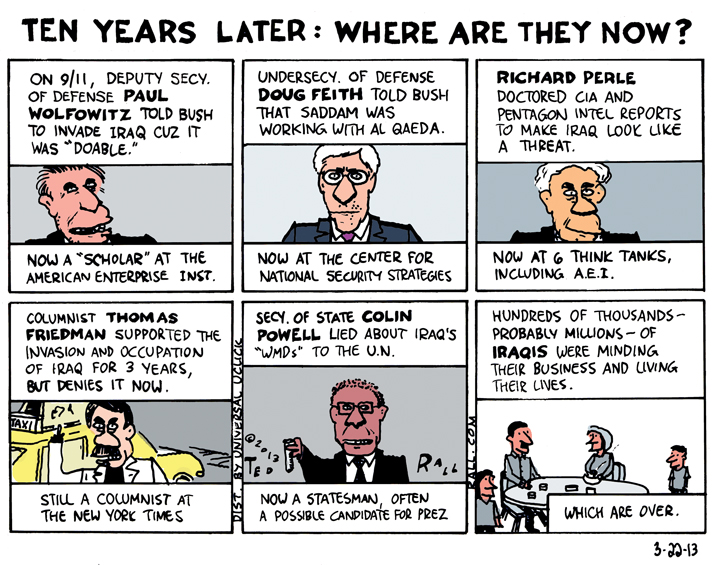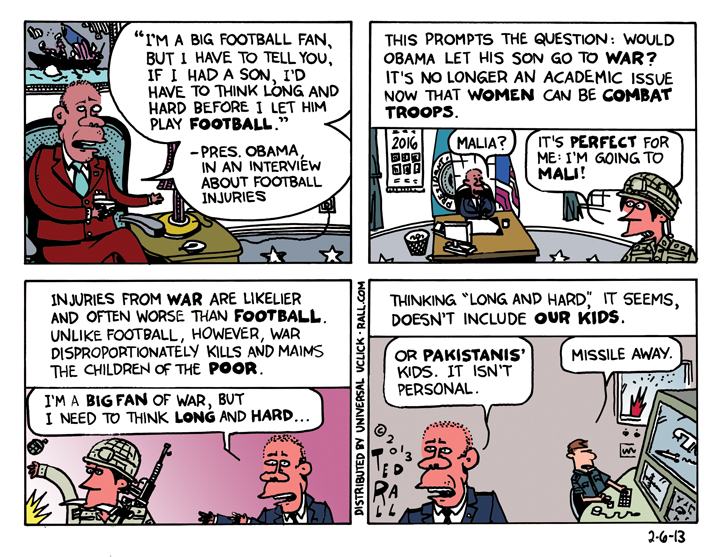When You Ask “Why?,” Mean It.
Why?
Why would anybody want to kill innocent people?
That’s what Americans — led by the media reporters and pundits who set the agenda for discussion — ask after every terrorist attack, particularly those carried out by foreigners.
Our mystified national cluelessness begs the question. Why do people blow up our embassies, bomb our ships, fly planes into our buildings, (try to) blow up their shoes and their underwear? They do it (partly) because we can’t imagine why anyone would do such a thing.
Studies, particularly the ones the media trots out at times like these, point to a number of factors. Some of these may help trigger the kind of violent “self-radicalization” that initial reports indicate may have led Tamerlan and Dzhokhar Tsarnaev, Kyrgyzstani brothers of Chechen descent, to detonate a pair of bombs at the Boston Marathon last week.
Was it psychological alienation? “I don’t have a single American friend,” Tamerlan, 26, supposedly the instigator of the attack, said. A traumatic event, like a job loss or the break-up of a romantic relationship? Some studies find that some self-radicalized (as opposed to those who are recruited into an organization) terrorists are made after they suffer a disappointment that sets them off, causing a person with political rage to graduate to violent direct action. After the Fort Hood shooting, the Pentagon concluded that substance abuse, post-traumatic stress syndrome or brain injuries sustained in an IED blast could be triggers. Some even blame the involvement of Dzhokhar, 19 and suffering from multiple gunshot wounds, on reports that he was a pothead.
But hey, one could just as easily ask what drove state terrorist Barack Obama to murder thousands of innocent people with killer drones. Was the president sad after failing to win a second Nobel Prize? Did Michelle stop putting out? Did cocaine and/or marijuana scramble his right temporo-parietal junction, the part of the brain that controls the moral judgments of human beings? It’s pretty safe to say we’ll never be able to point to one, or two, or 17 discrete factors as the “causes” for the conscious choice to kill another person.
Like the drone war, the Boston Marathon bombings were a political act.
At this point, my best guess is that this was an attempt to strike back at the U.S. in its post-9/11 “great war of civilizations,” or Christian “crusade,” as George W. Bush called it. Authorities who questioned Dzhokhar in his hospital bed say that he and Tamerlan wanted to defend Islam from attack.
You can argue that the Tsarnaev brothers’ politics were wrong. That their tactics were counterproductive. That they were just “losers,” as their uncle called them. But we can’t understand why unless we dig into those politics.
Which is something that, 12 years after 9/11, the American media still refuses to do. Which increases the odds of future attacks.
Terrorism is not prima facie the act of a nut. Serial killers don’t detonate bombs. Terrorists don’t terrorize for fun.
“Terrorism [as opposed to state terrorism, like the drone wars] is the tool of the weak, used by disaffected groups or minorities to oppose the rule and (as they see it) the oppression of an established and militarily superior power,” Mark Nicholson wrote. “Because it is resistance on the cheap, terrorism often emerges out of civil society rather than state sponsorship, because oppressed civilian groups, lacking control over governmental machinery, can summon little or no regular military force able to confront their ‘oppressor’ in conventional military terms.”
We like terrorists. Some of them, anyway. During World War II German occupation forces characterized the leaders of the Warsaw ghetto uprising as “terrorists.” We view these doomed Jews, who fought to the death, as noble. The Afghan mujahedeen who struggled against the Soviets during the 1980s were terrorists to the USSR, “freedom fighters” to Ronald Reagan. The French Resistance assassinated public officials and robbed banks and bombed trains, and we love ’em for it. In movies like “Red Dawn,” we cheer the patriotic American “terrorists” who wage guerilla warfare against the invaders.
This, of course, is how radical Islamists see themselves: as heroic fighters in a resistance movement against a rapacious, cruel oppressor. (And if they prevail, that’s how history will read.) They’re not psychotic. They’re principled, willing to sacrifice everything for their cause.
Since 9/11 our leaders have repeatedly told us that “they” “hate our freedoms,” but of course this is nonsense. As Osama bin Laden remarked, if the Islamists resented liberal societies, if they wanted the world’s women all under burqas, Amsterdam would have been blown to bits. “We only killed Russians after they invaded Afghanistan and Chechnya, we only killed Europeans after they invaded Afghanistan and Iraq,” bin Laden wrote in 2004.
To ask why Tamerlan and Dzhokhar Tsarnaev did what they did (if indeed they did it), to research their political motivations with an open mind, without dismissing them as random (friendless, stoned, loser) crazies, does not legitimize their tactics.
Self-styled Islamist resistance organizations like Al Qaeda haven’t garnered widespread support because terrorism against civilians is counterproductive. As Ché Guevara wrote, “terrorism [is] a measure that is generally ineffective and indiscriminate in its results, since it often makes victims of innocent people and destroys a large number of lives that would be valuable to the revolution.”
However, as Ché continued, terrorism directed against government or military officials can be legitimate: “Terrorism should be considered a valuable tactic when it is used to put to death some noted leader of the oppressing forces well known for his cruelty, his efficiency in repression, or other quality that makes his elimination useful.” After 9/11, for example, even some Americans viewed the Pentagon as a legitimate military target. Conversely, arguments that the World Trade Center, as a hub of a “technocratic corps at the very heart of America’s global financial empire,” was an acceptable target, were rejected. The WTC victims enjoy an exalted sainthood in popular culture; grief over the Pentagon victims has always been relatively muted.
No would-be revolutionary who knows history would have targeted a civilian target like the Boston Marathon.
So, let’s agree that the brothers’ tactics sucked. That what they did was evil. But what of their political motivations?
One would have to be blind not to understand why Muslims are enraged at the U.S.: Gitmo, drones, propping up dictators, Palestine, Abu Ghraib, Afghanistan, Iraq, the list goes on and on…and yes, Chechnya — where the Russians slaughtered thousands of innocents while their American allies silently cheered them on.
But few of us know about that. Because our media didn’t report it.
Which gets us back to:
Why’d the Boston bombers do it?
To get us to pay attention.
So we’ll force “our” government to stop what they’re doing in Muslim countries.
But that’ll never happen until we know “we’re” doing.
(Ted Rall’s website is tedrall.com. His book “After We Kill You, We Will Welcome You Back As Honored Guests: Unembedded in Afghanistan” will be released in November by Farrar, Straus & Giroux.)
COPYRIGHT 2013 TED RALL






